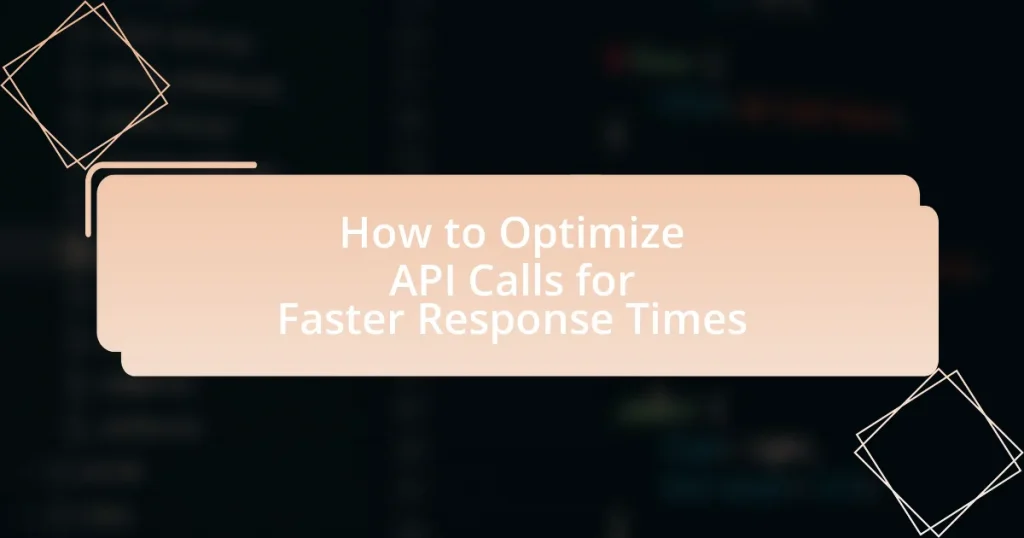API calls are essential requests made by clients to servers for data retrieval or transmission via an Application Programming Interface (API). This article explores the significance of API calls in modern web architecture, detailing their functionality, the protocols commonly used, and the factors influencing response times. It also examines optimization techniques such as caching, reducing payload size, and employing asynchronous requests to enhance performance. Additionally, the article discusses best practices for API design, tools for monitoring performance, and strategies for effective implementation, all aimed at achieving faster response times and improved user experiences.
What are API Calls and Why are They Important?
API calls are requests made by a client to a server to retrieve or send data using an Application Programming Interface (API). They are important because they enable communication between different software applications, allowing them to share data and functionality seamlessly. For instance, in 2021, over 80% of web traffic was generated by APIs, highlighting their critical role in modern web architecture. API calls facilitate integration, enhance user experiences, and support the development of complex applications by allowing developers to leverage existing services and data sources efficiently.
How do API Calls function in web applications?
API calls in web applications function as requests made by a client to a server to retrieve or send data. When a user interacts with a web application, the frontend sends an HTTP request to a specific endpoint of the API, which is designed to handle that request. The server processes the request, performs any necessary operations (such as querying a database), and then sends back a response, typically in JSON or XML format. This response contains the requested data or confirmation of the action taken, allowing the web application to update the user interface accordingly. The efficiency of API calls can significantly impact the overall performance of web applications, as faster response times lead to a better user experience.
What protocols are commonly used for API Calls?
Commonly used protocols for API calls include HTTP, HTTPS, and WebSocket. HTTP (Hypertext Transfer Protocol) is the foundational protocol for data communication on the web, while HTTPS (HTTP Secure) adds a layer of security through encryption. WebSocket, on the other hand, enables full-duplex communication channels over a single TCP connection, allowing for real-time data transfer. These protocols are widely adopted due to their efficiency and compatibility with various web technologies, making them essential for optimizing API calls and ensuring faster response times.
How do API Calls facilitate communication between services?
API calls facilitate communication between services by enabling them to exchange data and functionality over the internet. This is achieved through standardized protocols such as HTTP, which allows one service to request information or actions from another service. For instance, when a web application needs to retrieve user data from a database, it sends an API call to the server hosting that database, which then processes the request and returns the relevant information. This interaction is essential for microservices architecture, where different services must work together seamlessly. The use of APIs allows for modular development, where services can be updated independently without affecting the entire system, thus enhancing scalability and maintainability.
What factors influence the response time of API Calls?
The response time of API calls is influenced by several key factors, including network latency, server performance, and the complexity of the request. Network latency refers to the time it takes for data to travel between the client and server, which can be affected by geographical distance and network congestion. Server performance encompasses the processing power and resource availability on the server side, where higher loads can lead to slower response times. Additionally, the complexity of the request, such as the amount of data being processed or the number of database queries involved, can significantly impact how quickly an API can respond. These factors collectively determine the efficiency and speed of API interactions.
How does network latency affect API performance?
Network latency negatively impacts API performance by increasing the time it takes for requests to travel between clients and servers. High latency can lead to slower response times, which affects user experience and application efficiency. For instance, a study by Akamai found that a 100-millisecond increase in latency can reduce conversion rates by 7%. This demonstrates that minimizing network latency is crucial for optimizing API calls and ensuring faster response times.
What role does server processing time play in response times?
Server processing time significantly impacts response times by determining how quickly a server can process requests and generate responses. When server processing time is high, it leads to increased latency, resulting in slower response times for users. For instance, a study by Google found that a delay of just 100 milliseconds can reduce conversion rates by 7%. Therefore, optimizing server processing time is crucial for enhancing overall response times and improving user experience.
How can API Calls be optimized for faster response times?
API calls can be optimized for faster response times by implementing techniques such as caching, reducing payload size, and using asynchronous requests. Caching frequently requested data minimizes the need for repeated calls to the server, significantly decreasing response times. For instance, using tools like Redis can store responses temporarily, allowing for quicker access. Reducing payload size by only sending necessary data decreases the amount of information transmitted, which can lead to faster processing. Additionally, employing asynchronous requests allows multiple API calls to be made simultaneously, rather than sequentially, improving overall efficiency. These methods are supported by performance studies indicating that optimized API calls can reduce latency by up to 50%.
What techniques can be employed to reduce API response times?
To reduce API response times, techniques such as caching, optimizing database queries, and using asynchronous processing can be employed. Caching frequently requested data minimizes the need for repeated database access, significantly speeding up response times. Optimizing database queries, such as indexing and reducing the complexity of queries, enhances data retrieval efficiency. Asynchronous processing allows the API to handle multiple requests simultaneously, improving overall throughput. These methods are supported by studies indicating that effective caching can reduce response times by up to 90%, while optimized queries can decrease execution time by 50% or more.
How does caching improve API performance?
Caching improves API performance by storing frequently accessed data, which reduces the need for repeated database queries or computations. When an API request is made, the system first checks the cache for the requested data; if it is available, the response is delivered quickly from the cache rather than generating it anew. This significantly decreases response times and reduces server load, leading to improved scalability. Studies have shown that implementing caching can reduce response times by up to 90%, as it minimizes the time spent on data retrieval and processing.
What is the impact of reducing payload size on response times?
Reducing payload size significantly improves response times. Smaller payloads require less bandwidth and processing power, leading to faster data transmission and quicker server responses. For instance, studies have shown that reducing payload size by 50% can lead to a response time improvement of up to 30%, as less data is transferred over the network. This efficiency is particularly crucial in environments with limited bandwidth or high latency, where every byte counts in optimizing performance.
How can API design contribute to faster response times?
API design can significantly contribute to faster response times by optimizing data structures and minimizing payload sizes. Efficiently structured APIs reduce the amount of data transmitted, which directly decreases the time taken for requests and responses. For instance, using JSON over XML can lead to smaller payloads, as JSON typically requires less overhead. Additionally, implementing pagination and filtering allows clients to request only the necessary data, further enhancing speed. According to a study by Google, optimizing API responses can lead to a reduction in latency by up to 50%, demonstrating the tangible benefits of thoughtful API design.
What are the best practices for structuring API endpoints?
The best practices for structuring API endpoints include using clear and consistent naming conventions, organizing endpoints hierarchically, and employing appropriate HTTP methods. Clear naming conventions enhance readability and usability, while a hierarchical organization reflects the resource relationships, making it easier for developers to navigate the API. For instance, using nouns to represent resources (e.g., /users, /orders) and verbs for actions (e.g., GET, POST) aligns with RESTful principles. Additionally, employing versioning in the endpoint (e.g., /v1/users) allows for backward compatibility and easier updates. These practices are supported by industry standards such as REST and GraphQL, which emphasize clarity and efficiency in API design.
How does versioning affect API performance?
Versioning can significantly impact API performance by introducing overhead in request processing and response handling. When an API is versioned, the server must manage multiple code paths and data structures to accommodate different versions, which can lead to increased latency. For instance, if an API has three versions, the server may need to perform additional checks to determine which version of the code to execute, potentially slowing down response times. Additionally, maintaining backward compatibility can complicate the codebase, leading to inefficiencies. Studies have shown that poorly managed versioning can increase response times by up to 30%, as indicated in research by the API Performance Benchmarking Group.
What tools and technologies can assist in optimizing API Calls?
Tools and technologies that assist in optimizing API calls include API gateways, caching mechanisms, and load balancers. API gateways, such as Amazon API Gateway and Apigee, manage traffic and enforce policies, which can reduce latency and improve security. Caching solutions like Redis and Memcached store frequently accessed data, minimizing the need for repeated API calls and thus enhancing response times. Load balancers, such as NGINX and HAProxy, distribute incoming API requests across multiple servers, ensuring no single server becomes a bottleneck, which further optimizes performance. These tools collectively contribute to faster and more efficient API interactions.
What monitoring tools are available for tracking API performance?
Monitoring tools available for tracking API performance include Postman, New Relic, Datadog, and Apigee. Postman provides a user-friendly interface for testing and monitoring APIs, allowing users to track response times and performance metrics. New Relic offers comprehensive monitoring capabilities, including real-time analytics and error tracking, which help identify performance bottlenecks. Datadog integrates with various services to provide detailed insights into API performance, including latency and throughput metrics. Apigee, a Google Cloud product, specializes in API management and monitoring, offering tools to analyze traffic patterns and optimize performance. These tools are widely used in the industry to ensure efficient API performance and enhance user experience.
How can logging help identify bottlenecks in API Calls?
Logging helps identify bottlenecks in API calls by providing detailed records of request and response times, error rates, and system resource usage. These logs allow developers to analyze the performance of each API endpoint, pinpointing where delays occur and under what conditions. For instance, if logs show consistently high response times for a specific endpoint during peak usage, it indicates a potential bottleneck that may require optimization, such as code refactoring or infrastructure scaling. Additionally, logging can reveal patterns in error occurrences, helping to identify not only performance issues but also underlying problems that may contribute to slowdowns.
What role do load testing tools play in optimization?
Load testing tools play a crucial role in optimization by simulating user traffic to identify performance bottlenecks in applications. These tools help developers understand how an API behaves under various load conditions, enabling them to pinpoint issues such as slow response times or system failures. For instance, a study by the Performance Engineering Research Group at the University of Alberta found that load testing can reduce response times by up to 50% when performance issues are addressed before deployment. By providing actionable insights, load testing tools facilitate the enhancement of API efficiency and reliability, ultimately leading to improved user experience.
How can developers implement optimization strategies effectively?
Developers can implement optimization strategies effectively by employing techniques such as caching, minimizing data transfer, and optimizing database queries. Caching frequently accessed data reduces the need for repeated API calls, thereby improving response times. Minimizing data transfer involves sending only necessary information in API requests and responses, which decreases load times and bandwidth usage. Optimizing database queries ensures that data retrieval is efficient, reducing the time taken to process requests. These strategies are supported by industry practices that demonstrate significant performance improvements, such as a study by Google showing that reducing payload size can lead to faster load times and better user experience.
What are common pitfalls to avoid when optimizing API Calls?
Common pitfalls to avoid when optimizing API calls include over-fetching data, under-fetching data, neglecting caching strategies, and failing to monitor performance metrics. Over-fetching occurs when an API returns more data than necessary, leading to increased latency and bandwidth usage. Under-fetching happens when an API does not provide enough data in a single call, requiring multiple requests and thus increasing response time. Neglecting caching strategies can result in unnecessary repeated calls to the server, which can slow down response times. Lastly, failing to monitor performance metrics can prevent developers from identifying bottlenecks and optimizing the API effectively. These pitfalls can significantly hinder the efficiency of API calls and should be carefully managed.
How can continuous integration and deployment enhance API performance?
Continuous integration and deployment (CI/CD) enhance API performance by enabling rapid and consistent updates, which lead to improved functionality and reduced downtime. CI/CD practices automate the testing and deployment processes, allowing for frequent code changes that can be validated and released quickly. This results in faster identification and resolution of performance issues, as automated tests can catch regressions before they reach production. Furthermore, CI/CD facilitates the use of performance monitoring tools that provide real-time feedback on API performance, enabling teams to make data-driven decisions for optimization. Studies show that organizations implementing CI/CD can achieve deployment frequency up to 200 times more than those without, significantly improving responsiveness to user needs and system performance.
What are some practical tips for optimizing API Calls?
To optimize API calls, implement techniques such as reducing payload size, using caching, and minimizing the number of requests. Reducing payload size can be achieved by sending only necessary data, which decreases bandwidth usage and speeds up response times. Caching frequently requested data reduces the need for repeated calls to the server, significantly improving performance; for instance, using HTTP caching headers can allow clients to store responses temporarily. Minimizing the number of requests can be accomplished by batching multiple requests into a single call, which reduces latency and improves efficiency. These strategies are supported by industry practices that emphasize performance enhancement in API design.















